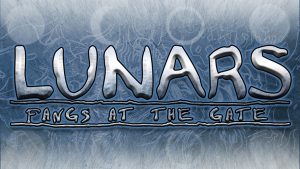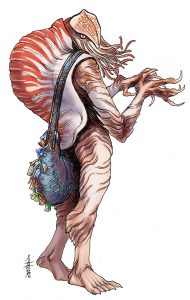
Originally posted as yesterday’s update on our Kickstarter for Lunars: Fangs at the Gate for Exalted 3rd Edition.
The Lunars are peerless shapeshifters, clothing themselves in the skins of fierce beasts or stolen faces. Their protean power evinces their predatory nature; before a Lunar can take a human’s or animal’s shape, she must consume its heart’s blood in the ritual called the sacred hunt.
A Lunar may enter an animal or human shape she possesses as a miscellaneous action, committing four motes for the transformation’s duration. This can be flurried, but not with attack actions. She may reflexively revert back to her true human form by releasing this commitment.
Note that these rules depict Lunars’ baseline potential. Individual Lunars may take Charms that refine or expand their shapeshifting prowess.
What Are Animals?
Lunars are limited to taking human and animal forms — they can’t take become magical beasts, elementals, demons, or other strange creatures. However, Creation is home to many animals extinct or fictional on Earth, and the difference between them and magical beasts isn’t always obvious. If not specified, the Storyteller determines whether a creature is an animal. Any intrinsic supernatural power, like a fogshark’s ability to swim through mist, is disqualifying. Beyond that, the Storyteller’s decision should be guided by whether she can envision the creature existing in the real world (possibly in some prehistoric era). If she thinks it’s plausible, it’s probably an animal.
Animal Shapes
Taking an animal shape has the following effects:
- The Lunar’s Essence, Willpower, base Initiative, health levels, Attributes, Abilities, Resolve, and Guile are unaffected.
- She loses any mutations she possesses intrinsically (but not those granted by Charms), with the exception of mutations tied to her Tell.
- When she takes an action the animal has a listed dice pool for, she may use its dice pool. Any dice over her own base (Attribute + Ability) pool count as Charm dice and are subject to her dice cap (p. XX), potentially preventing her from using a form’s full dice pool. If the animal’s pool is lower than hers, or it has no listed pool, she may use her own dice pool, although the Storyteller may assess penalties if her shape is ill-suited to that action.
- She may use the animal’s natural weapons, including their listed dice pool and damage value. (Note that she uses the same pool for withering and decisive attacks). Any dice over her own base (Dexterity + Brawl) count as Charm dice, but damage doesn’t count against the amount she may add with the Strength Excellency. If her (Dexterity + Brawl) pool is higher than the attack pool for a natural weapon, her withering attacks with it gain +1 Accuracy.
- She may attempt any feat of strength that the animal is capable of performing. If the animal’s effective Strength rating is lower than her own, she’s limited to the lower value. If the form doesn’t list a Strength rating for the purpose of feats, it’s assumed to have Strength 1.
- She may use the animal’s Evasion and Parry instead of her own. Any amount over her own base values counts as a Charm bonus.
- She may use the animal’s natural soak and Hardness ratings instead of her own. This isn’t a Charm bonus.
- She gains the animal’s innate special abilities and Merits. Dice or successes added by these count as Charm bonuses.
- She may unlock an animal shape’s mundane latent abilities (but not magical abilities) for six experience points or three bonus points each. Once she’s unlocked a latent ability for one form, it’s unlocked for all forms capable of using it. She doesn’t need to unlock latent abilities to use the distract, disarm, and unhorse gambits in animal forms.
- Her ability to communicate is limited by the animal’s anatomy. Most are incapable of speaking human languages, forcing her to rely on body language and whatever noises she can make (Exalted, p. 221).
Most Lunars can’t change into the shapes of animals with Legendary Size or Minuscule Size. Doing so requires Towering Beast Form or Emerald Grasshopper Form, respectively. Note that a Lunar lacking these Charms can still take the shapes of such animals, or choose one as her spirit shape, though she must learn the appropriate Charm before she can take its form.
Acquiring Forms: The Sacred Hunt

A Lunar begins with her own human shape and her spirit shape, and may take the Heart’s Blood and Stolen Faces Merits to begin play with additional forms. Gaining new forms in play requires a sacred hunt.
The hunt begins when the Lunar’s player declares her intention to take a specific human’s or animal’s shape. She must then hunt down and kill her prey. There’s no minimum time she must spend hunting, but she must declare her intention beforehand — she can’t declare a sacred hunt against an enemy she’s in the midst of fighting. Others may assist her, but she must deal the killing blow herself, either directly through an attack or indirectly, with traps, poison, etc. Once her prey is killed, she may take its form by drinking its heart’s blood — the blood that flows through its heart, or the nearest analogue.
When a Lunar performs the sacred hunt to take a human’s shape, she must form a Tie towards that individual at the conclusion of the hunt, if she doesn’t have one already. She doesn’t need to keep this Tie to retain access to his shape, but taking human forms isn’t done lightly or without emotional consequences.
Bear in mind that the Storyteller can always choose to skip combat (Exalted, p. 212), and is encouraged to do so when a Lunar performs a sacred hunt against prey that can’t offer meaningful resistance. Likewise, the Storyteller may let a Lunar perform sacred hunts over downtime to take new forms that pose no obstacle to her.
Drinking heart’s blood is the most common sacred hunt, but not the only one. Some Charms grant access to alternative sacred hunts. These have different requirements for taking the target’s form, although all require a declaration of intent beforehand.
The Tell
Every Lunar has a Tell, a distinctive mark that appears in any form she takes. It might be an animal feature, like a leopard’s tail or a ram’s horns; a distinctive physical trait, like a blind eye or a prominent scar; a non-visual trait, like a pungent scent or a songbird-like voice; or a subtle supernatural display, like a shadow that moves independently. If a Tell is inappropriate to a specific animal form, it might shift into a more suitable appearance while remaining distinctively identifiable, e.g., if a Lunar whose Tell is goat-like eyes becomes an eyeless animal, she might manifest distinctive eye-like markings.
The Tell’s nature is to conceal itself. Nontrivial characters can attempt a difficulty 7 (Perception + Awareness) roll to notice a Lunar’s Tell. Characters who’ve previously detected the Lunar’s Tell receive three bonus dice. Magic that enhances attempts to see through disguises applies on this roll. Success lets them notice the Tell, or, if they’ve noticed it before in a different form, identify her as the same individual. On a failure, that character can’t attempt the roll while the Lunar remains in her current shape. If a Lunar behaves inconsistently with one of her animal or human shapes, witnesses knowledgeable enough to recognize the discrepancy may roll to detect her Tell again with 1-3 bonus dice. The Storyteller should award higher bonuses for more egregious discrepancies, and for onlookers who verify their suspicions with read intentions or profile character actions.
While circumstances may impose penalties on rolls to notice a Lunar’s Tell, she can never render it completely impossible to detect unless she knows Subtle Silver Declaration. Once the Lunar’s anima reaches the glowing level, her Tell becomes obvious.
A Lunar whose Tell is a physical feature may take a mutation, such as Gills or Unusual Hide, to represent it. The Tell’s innate concealment doesn’t prevent onlookers from noticing her mutation, but they must still roll to connect the Lunar with other forms they’ve observed with the same Tell.
